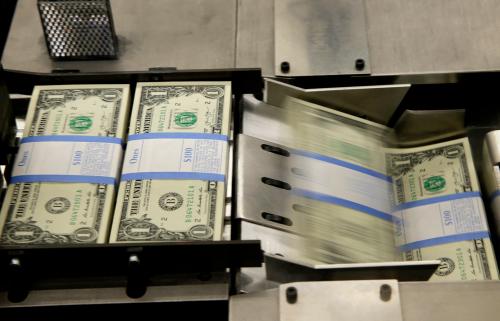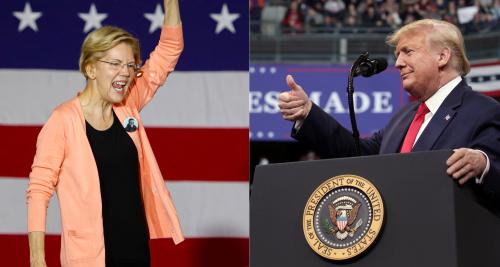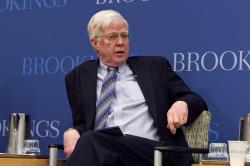This article was original posted on The Hill on December 6, 2016.
In the aftermath of Donald Trump’s election to the presidency, the value of the dollar has ascended in international markets, and the trade-weighted exchange rate rose by 3.5 percent during the month of November alone. Not only did most analysts not anticipate Trump’s victory, the general expectation was that dollar exchange rate would fall in that event. In addition to demonstrating the vulnerability of polls and forecasts, the rise in the dollar’s value raises ex post questions of why it occurred and what it means for the future of the economy.
The exchange rate is simply the price of dollars in terms of a foreign currency. If a foreign entity wants to buy an American product, service, or financial asset, they must first buy dollars, and a rising exchange rate implies a strong demand for those dollars.
Fluctuations in exchange rates are notoriously hard to predict because they depend so heavily on expectations. That is particularly true of changes on a bilateral basis, such as the dollar-yen rate, because we do not know if they reflect changes in one country or the other.
More meaningful patterns can be observed by comparing the exchange value of a currency to a broad average of its trading partners.
On the evening of Trump’s election, investors feared financial disorder in reaction to some of his extreme campaign promises and the dollar initially fell sharply in value. Investors quickly turned their attention to his economic policies and what they might mean for investments in the United States.
Trump has promised large business tax cuts and a much more expansionary fiscal position that should raise government borrowing and interest rates. All of this is good news for owners of capital, and investment funds have poured into the United States, driving up the dollar exchange rate.
However, it is also important to view these changes from a longer-term perspective where the value of the dollar has been steadily appreciating for the past five years – 30 percent since early 2011. During that period the United States has been a lone bright spot in the global economy.
With unemployment below the historic norm, record levels of corporate profits, and the Federal Reserve now poised to raise interest rates, financial capital is being redirected to dollar-denominated assets. It is the judgment of global investors that the United States has completed its long recovery from the financial crisis and is on the verge of a return to normality.
Investors also appear to believe that Trump’s more extreme statements about the global economy can be massaged away, and his election will initiate a period of lower capital taxation and other pro-business policies.
It is the judgment of global investors that the United States has completed its long recovery from the financial crisis and is on the verge of a return to normality.
What does a higher value of the dollar mean for the U.S. economy? First, much depends on where you sit.
A high value of the dollar is good for consumers – it is a favorable time to vacation abroad, and foreign-produced goods have declined dramatically in cost. Prices of imported goods have held down consumer price inflation and contributed to the rise in real incomes.
On the other hand, for those who are employed in export-based jobs, the high cost of American-made goods will tend to drive down exports and increase the pressures to produce abroad.
Second, for comparisons with trade, it is important to focus on real, or inflation-adjusted, values since, for many countries, the change in the nominal exchange rate is simply an offset to relatively high rates of domestic inflation.
This is particularly important in comparing the United States to China. The Chinese inflation-adjusted exchange rate has appreciated even more than that of the United States over the past decade.
Finally, we should recognize the response of trade flows to an exchange rate change will stretch over several years as both exporters and importers wait to see if it will be enduring. Most recent studies of U.S. trade suggest a lag response stretching over 2-3 years.
Those studies also typically conclude that a 10 percent appreciation of the dollar would lead to a long-run increase in the U.S. trade deficit by about 1 percent of GDP. Thus, we should anticipate that a continued strong dollar should exert a drag on the U.S. economy as a widening of the trade deficit from the current 3 percent of GDP to about 4 percent in the next 1-2 years.
The recent appreciation will make it difficult to achieve President-elect Trump’s goal of narrowing the trade deficit. However, the exchange rate is still below its 2005 peak, and the magnitude of the trade deficit is far below the levels reached in the mid-2000s.
The anticipated change in the trade balance is also occurring against the backdrop of a surprisingly weak performance of global trade in recent years. This suggests that the response to exchange rates may be more damped than in the past.
At present, the strong dollar reflects investors’ relative optimism about their prospective returns on dollar-denominated assets, and not a precursor of a deteriorating trade performance. Whether their optimism is justified remains to be determined.
The Brookings Institution is committed to quality, independence, and impact.
We are supported by a diverse array of funders. In line with our values and policies, each Brookings publication represents the sole views of its author(s).






Commentary
Op-edRise in dollar shows short-term support of Trump’s pro-business platform
December 7, 2016